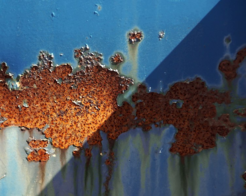Corrosion: We rest, the world rusts
by Claudia Merola, MPI für Eisenforschung GmbH
The word “atom” comes from the Greek word "atomos", meaning indivisible. Therefore, even if their thought was not accurate, the ancient Greek philosophers already stated the presence of atoms as the smallest constituent of matter. The two most important philosophers that talked about atoms were Democritus and Aristotle.

Democritus believed that everything was a result of natural laws. He explained that matter is composed of atoms, which are physically - but not geometrically - indivisible, and that they are separated by empty spaces. Moreover, he added that atoms are indestructible and always in motion. Aristotle vehemently opposed the atomic theory developed by Democritus. He believed that matter was not made of tiny particles called atoms but of four different fundamental elements: air, fire, water, and earth.
Democritus’ thoughts were later proven to be partially correct. Nowadays we know, of course, that all elements are made of atoms that are divisible and composed of protons, neutrons, and electrons. However we will need a couple more centuries to actually reach this standpoint. These constituent parts of matter are indispensable in understanding many day-to-day phenomena.
These constituents of matter, i.e. atoms, are indispensable in understanding many day-to-day phenomena. Now I would like to ask you to look around your office, your room - try to focus on the objects and to mentally remove all of them that contain or are made of some metal. I wonder how many objects you can still see. I guess there is not much left. And yet, all of us have noticed that rust forms on many of these metal pieces if they are exposed to air and bad weather. This phenomenon, that takes place due to interactions at the atomic levels in metals is what chemists call “Corrosion”.
The branch of science that studies corrosion is called electrochemistry, which is the study of chemistry to use or produce electricity. Reactions like corrosion happen at electrodes, which are made of conductive materials (i.e. metal) placed in contact with an electrolyte, a solution that contains ions (an atom or molecule that has a non-zero net electrical charge). During electrochemistry reactions, electrons are exchanged between the metal and the electrolyte, so the oxidation number of the elements involved is changed. If the element gains electrons it is said to be reduced, and if it loses electrons it is said to be oxidized. A redox reaction is when both oxidation and reduction are happening. If the reaction is spontaneous (ΔG < 0, where G is the Gibbs free energy, used in physics and chemistry to calculate the maximum reversible work that can be performed by a reversible system under constant temperature and pressure), the electrochemical reaction can be used to produce a current in an electrochemical cell. This is the basis of all batteries and fuel cells. On the other hand, a non-spontaneous electrochemical reaction (ΔG > 0) can happen by applying current at sufficient voltage. Water splitting would be a typical example of this. When corrosion happens, the electrochemical reactions involved are spontaneous.
Most corrosion phenomena are of an electrochemical nature and involve two or more electrode reactions. However, the most important thing to remember is that they always involve an anodic reaction (dissolution of the metal) and a cathodic reaction (reduction of an oxidizing agent). This means that no matter what we do, thermodynamics plays against us. The only factor which we can control is kinetics, or how fast the reaction is actually occurring. Because corrosion is a natural process and metals are part of our everyday life, a lot of money is invested every year in slowing down this phenomenon and investigating new methods to prevent it.
It is easy to find common objects that show signs of corrosion. Just think about automobiles that are composed of different materials such as metals, plastics, paints, metallic coatings, all of which are exposed to aggressive conditions like atmospheric agents or high temperature. If you observe an old car (e.g.“Tow Mater/ Hook” from the Pixar movie Cars), you will for sure see some corrosion products. Traffic signs, street lamps, and many other items seen along roads are usually manufactured of galvanized steel. Check them closely you will see some "white" corrosion (zinc oxide), characteristic of the oxidation of a zinc coating, in big red spots that indicate that the steel base is being corroded. The sea and the salty atmosphere are saline media that are highly aggressive to metals, so whatever is close to or directly immersed in this environment will show signs of corrosion if not well protected.
There are different ways to play with kinetics; they could be chemical methods like cathodic protection or galvanization (application of a zinc protective layer on iron) or physical methods like using paint as a physical barrier to prevent the oxygen in water and salt from reaching the surface of the metal. It is estimated that because of this protection, we could be able to reduce losses caused by corrosion by a factor of about 30 percent.
Now, if I have hopefully convinced you how important it is to study corrosion, you will understand why our department – Interface Chemistry and Surface Engineering - is investing so much resource into deeper understanding of this phenomenon. No matter how much has been done already, every study on how corrosion starts and propagates, or how to stop it, brings us a step closer to saving a huge amount of money and reducing waste.
Editor Viswanadh Gowtham Arigela
Literature
- https://plato.stanford.edu/entries/atomism-ancient/
- Corrosion Mechanism in Theory and Practice (P. Marcus)











